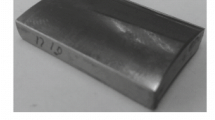Abstract
Metal-matrix composites may offer better damping properties than unreinforced alloys. Because damping properties (and metal-matrix composites) are becoming important in airframe design, the damping capabilities of a number of aluminum-matrix composites were measured over a wide range of frequencies at low strain amplitudes, using a new laser vibrometer technique. Silicon carbide and alumina reinforcements resulted in a material with damping properties similar to that of unreinforced aluminum 6061-T6, but unidirectional and planar-random graphite continuous-fiber reinforcements increased the damping by 5 and 14 times, respectively. The increased damping of the continuous fiber composites is attributed to the absence of interfacial reaction resulting from the high-pressure infiltration method used for their manufacture.
Similar content being viewed by others
References
K.K. Chawla, Composite Materials, ed. B. Ilscher and N. J. Grant (New York: Springer-Verlag, 1987).
S.P. Rawal and M.S. Misra, “Interfaces and Damping in Continuous Gr/Al Composites,” Role of Interfaces on Material Damping, roceedings of an international symposium held in conjunction with ASM’s Materials Week and TMS Fall Meeting, Toronto, ntario, Canada (October 13–17, 1985).
R.B. Bhagat, M.F. Amateau and E.C. Smith, “Damping Behavior of Mechanically Alloyed Aluminum-Matrix Composites,” itInternational Journal of Powder Metallurgy, 25(4) (1989), pp. 311–318.
R.B. Bhagat, M.F. Amateau and E.C. Smith, “Damping Behavior of Planar Random Carbon Fiber Reinforced 6061 Al Matrix omposites Fabricated by High-Pressure Infiltration Casting,” ASTM Journal of Composites Technology and Research, 11(3) (Fall 1989), pp. 113–116.
M.S. Misra, “Metallurgical Characterization of the Interfaces and the Damping Mechanisms in Metal Matrix Composites,” Progress Report No. 1, Martin Marietta, Denver, CO (1985), pp. 1–11.
P.K. Rohatgi et al., “Damping Capacity of Aluminum Alloy Matrix Composites,” Cast Reinforced Metal Composites, ed. S.G. Fishman and A.K. Dhingra (Metals Park, OH: ASM, 1988), pp. 375–381.
R.J. Sample, R.B. Bhagat and M.F. Amateau, “High Pressure Squeeze Casting of Unidirectional Graphite Fiber Reinforced Aluminum Matrix Composites,” Journal of Composite Materials, 23(10) (tOctober 1989), pp. 1021–1028.
R.B. Bhagat et al., “Squeeze Cast Metal Matrix Composites: Evaluation of Their Strength, Damping Capacity and Corrosion Resistance,” Journal of Composite Materials, 23 (September 1989), pp. 961–975.
R.B. Bhagat et al., “SiC Fiber Reinforced Aluminum Matrix Composites: High Pressure Squeeze Casting and Mechanical Properties,” Proceedings of the Seventh International Conference on Composite Materials, ICCM VII, Guangzhou, China (November 22–24, 1989), pp. 573–582.
A.S. Norwick and B.S. Berry, Anelastic Relaxation in Crystalline Solids (New York: Academic Press, 1972).
B.E. Read and G.D. Dean, The Determination of Dynamic Properties of Polymers and Composites (Bristol, England: Adam Hilger, 1978).
R. De Batist, Internal Friction of Structural Defects in Crystalline Solids, vol. 5, ed. S. Amelinckx, R. Gevers and J. Nihoul (New York: American Elsevier Publishing, 1972).
C. Zener, Elasticity and Anelasticity of Metals (Chicago: The University of Chicago Press, 1948).
M.C. Junger and D. Feit, Sound Structures and Their Interaction, 2nd ed. (Cambridge, MA: MIT Press, 1986).
Eugene Skudrzyk, Applied Research Laboratory, Penn State University, University Park, PA (August 1989), private communication.
E. Skudrzyk, Simple and Complex Vibratory Systems (University Park, PA: Penn State University Press, 1981).
W.K. Blake, “Radiation from Free-Free Beams under Influences of Light and Heavy Fluid Loading,” Report No. 3716 (Bethesda, MD: Naval Ship Research and Development Center, 1971).
J.W. McCoy and E.W. Franklin, “Dendritic Segregation in Particle-Reinforced Cast Aluminum Composites,” Reinforced Metal Composites, ed. S.G. Fishman and A.K. Dhingra (Metals Park, OH: ASM, 1988), pp. 237–242.
M.A. Bayoumi and M. Suery, “Structure and Mechanical Properties of SiC-Particle Reinforced Aluminum-Alloy Composites,” ICCM-VI & ECCMI, vol. 2, ed. F.L. Matthews et al. (New York: Elsevier, 1987), pp. 2.481–2.490.
S.P. Rawal et al., “Role of Residual Stresses in the Damping Behavior of Gr/Al Composites,” unpublished work.
R.J. Arsenault and S.B. Wu, “The Strengthening of PM vs Melted SiC/Al Composites,” Cast Reinforced Metal Composites,ed. S.G. Fishman and A.K. Dhingra (Metals Park, OH: ASM, 1988), pp. 231–236.
G.G. Wren and V.K. Kinra, “An Experimental Study of the Complex Dynamic Modulus,” Dynamic Elastic Modulus Measurements in Materials, ASTM STP 1045, ed. Alan Wolfenden (Philadelphia: ASTM, 1989).
S.P. Rawal and M.S. Misra, “Interfaces and Damping in Continuous Gr/Al Composites,” op. cit. 2.
C.A. Updike and R.B. Bhagat, “Development of Damped Metal Matrix Composites for Advanced Structural Applications,” ARL Technical Report No. 89-010, the Pennsylvania State University, University Park, PA (December 1989).
M.J. Pechersky, R.B. Bhagat, C.A. Updike and M.F. Amateau, “Control of Damping Characteristics of Graphite Fiber Reinforced Aluminum Composites,” Metal and Ceramic Matrix Composites: Processing, Modeling and Mechanical Behavior, ed. R.B. Bhagat, A.H. Clauer, P. Kumar and A.M. Ritter (Warrendale, PA: TMS, 1990), pp. 641–655.
Author information
Authors and Affiliations
Rights and permissions
About this article
Cite this article
Updike, C.A., Bhagat, R.B., Pechersky, M.J. et al. The damping performance of aluminum-based composites. JOM 42, 42–46 (1990). https://doi.org/10.1007/BF03220896
Issue Date:
DOI: https://doi.org/10.1007/BF03220896




